There is no shortage of challenges faced by a restaurant owner. From managing stock to attracting customers, you need to juggle a multitude of tasks. However, it all starts with setting the stage for a remarkable dining experience – and that begins with your menu.
A good menu design doesn’t just list the dishes; instead, it tells a story and paints a picture of what awaits the diners. Thus, it only makes sense that you spend a good amount of time creating something that truly communicates your vision.
Don’t worry if this sounds daunting; we’re here to help! This article will show you how to design a menu for your restaurant in 9 simple steps.
How to Design a Menu
- Write & Categorize Items
- Decide on the Descriptions
- Look for Inspiration
- Ensure Accessibility & Inclusivity
- Select High-Quality Images
- Choose Appropriate Fonts & Colors
- Explore Menu Design Tools
- Find the Right Type of Paper
- Gather Feedback
Let us explain how to design a menu in more detail.
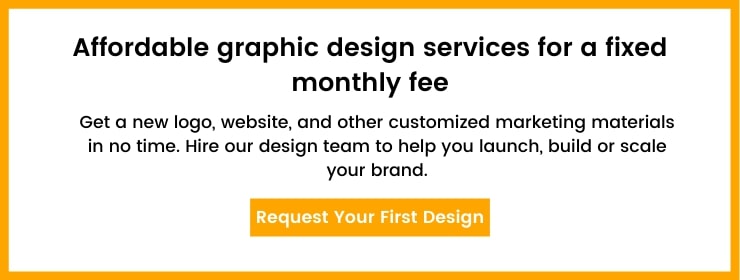
1. Write & Categorize Items
The first step in designing a menu is to write down all the dishes and then categorize them. It can be done into any logical groupings you prefer, such as food category (appetizers, entrees, mains, and desserts) or food type (salad, pizza, pasta, burger, etc). This step will help you create a proper structure and layout for your menu design.
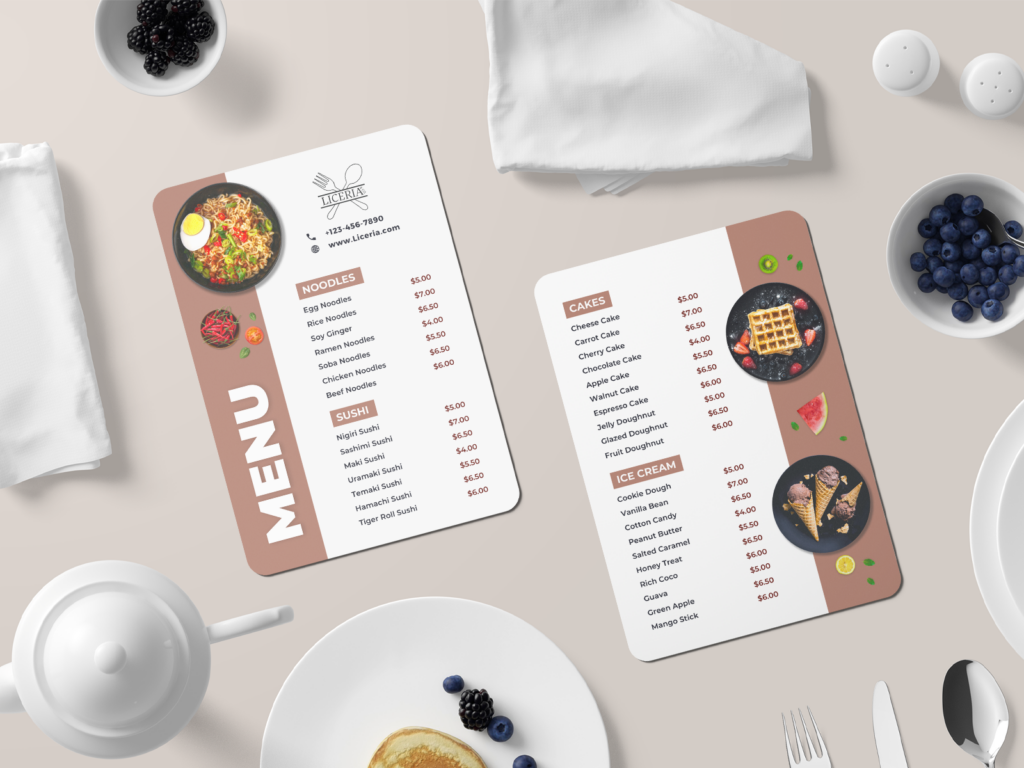
2. Decide on the Descriptions
Do you want to include descriptions alongside each dish in your menu? This is an important decision because there are pros and cons to both approaches.
On the one hand, including descriptions can help customers make decisions quickly, but from a design perspective, they can introduce visual clutter, especially when you have a lot of dishes. In fact, lengthy descriptions can overwhelm the reader and detract from the overall appeal of the menu.
We recommend that you find a middle ground, and instead of lengthy paragraphs, opt for concise, one-line descriptions. This approach will allow you to provide relevant details without overwhelming the reader or compromising the visual appeal of the menu.
3. Look for Inspiration
Now, it’s time to look for menu design inspiration. Start by exploring websites like Pinterest and Dribbble or simply search Google Images. It’s even better to create a mood board while doing your research in order to gather everything that catches your eye in one place.
Also, when looking for menu designs, pay close attention to various design elements and styles, including colors, typography, images, and layout. Save whatever you like in your mood board and try to identify common themes that resonate with your personal taste and the restaurant’s brand identity.
4. Ensure Accessibility & Inclusivity
Creating a menu that’s accessible and inclusive ensures that every customer, regardless of their abilities, can enjoy what you’re offering. It will involve:
- using clear and legible fonts,
- incorporating color contrast that promotes readability,
- providing clear labels for allergens and dietary restrictions, and
- making the menu available in multiple languages and formats.
It’s also important to keep these points in mind before you start designing a menu so that you can prioritize them. It would also help avoid bigger and costlier revisions later in the process.
5. Select High-Quality Images
Images are optional in a menu as a lot of people prefer minimalistic designs without any visuals. However, if you do opt for adding images to your menu, make sure you invest in a professional photographer to get good-quality results. Remember that low-quality images are worse than no images at all.
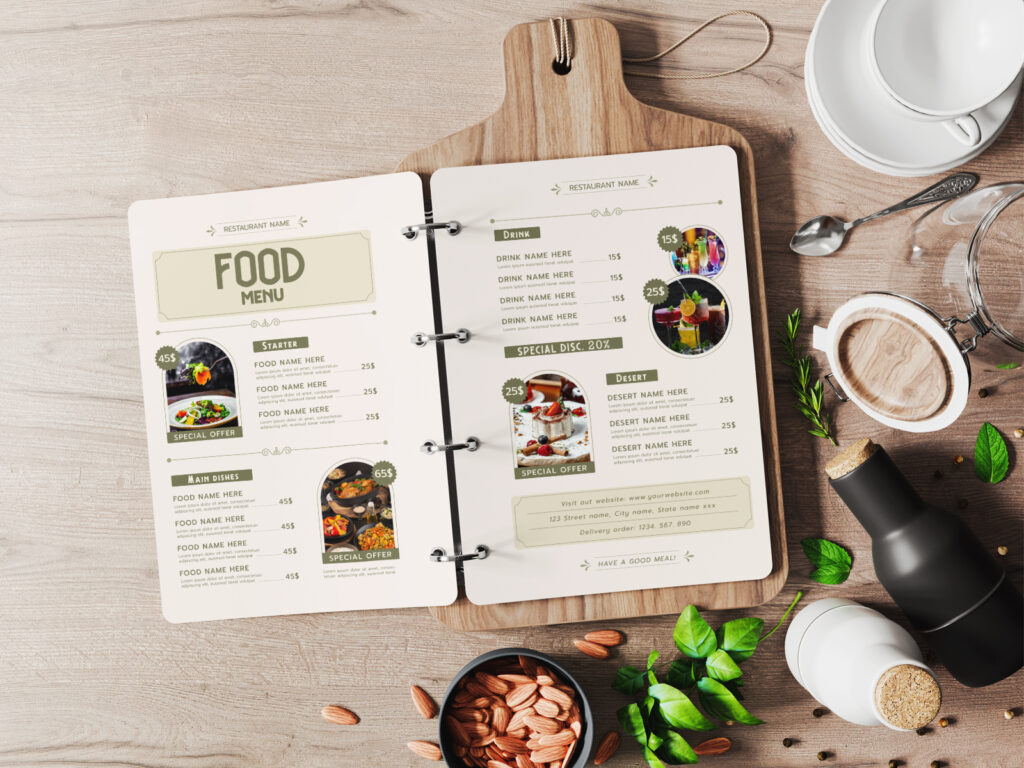
Alternatively, if you have budget constraints but you also want some visual elements in your menu, you can opt for illustrations. These will help enhance the aesthetics of your menu without compromising on quality. Here’s an example from our design portfolio:
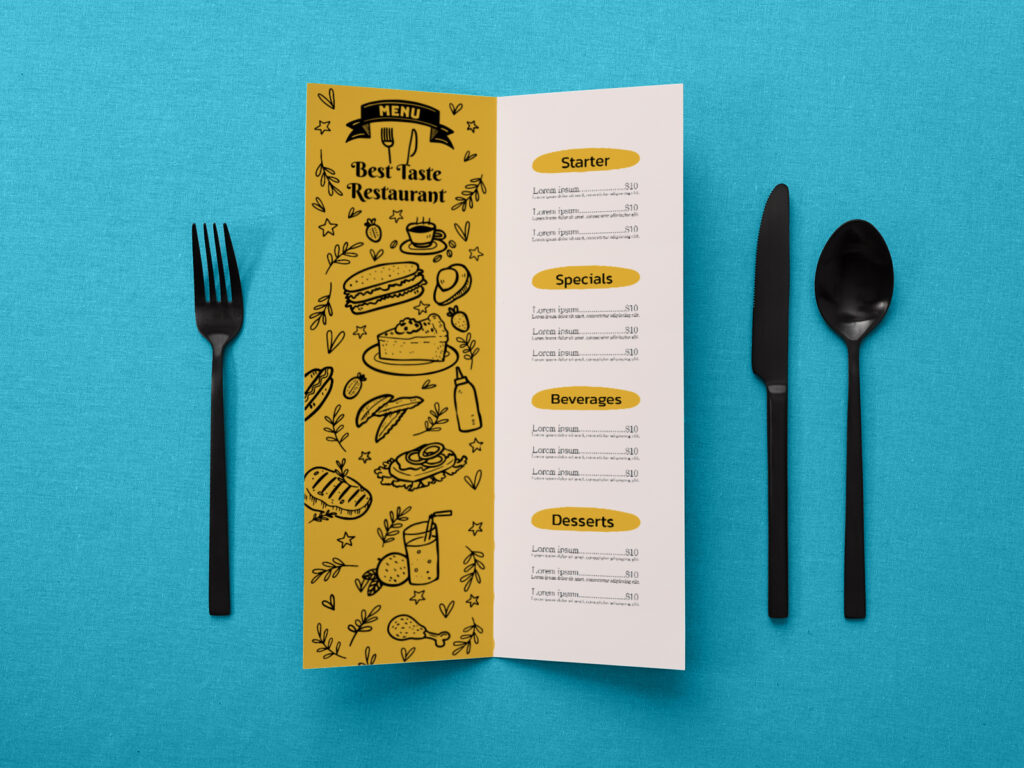
We have an article on our blog that’ll help you find royalty-free illustrations for your projects.

6. Choose Appropriate Fonts & Colors
First, let’s talk about the color scheme of your menu. It’s something that sets the tone and ambiance of your establishment. Therefore, depending on the vibe, you can opt for darker shades that represent fine dining or choose vibrant colors for a more casual or lively food joint like this one:

In most cases, your design would be based on your brand colors. However, if you haven’t settled on your brand color palette yet, here’s a guide to assist you: Learn How to Choose Brand Colors.
Now, coming to the fonts on the menu, it’s important to prioritize legibility whilst reinforcing your brand image. That means you cannot always use the same fonts that you might be using online for your websites or social media. You’ll need to select a font, such as Serif fonts, which are widely favored in print for their clarity and readability.
7. Explore Menu Design Tools
Once you have a complete picture of the overall design of your menu – we can actually get to work! This step will involve finding the right design tool, editing a template or creating something from scratch, and then adding all your brand elements with the menu items.
Firstly, since this is a tricky task, we highly recommend considering hiring a professional designer. You can sign up for our unlimited graphic design services, and we will assist you in designing your perfect restaurant menu.
However, if you’re working with a limited budget, you can still create a good menu design by using design tools like Canva. They offer various templates that you can search for on their website or start from scratch.
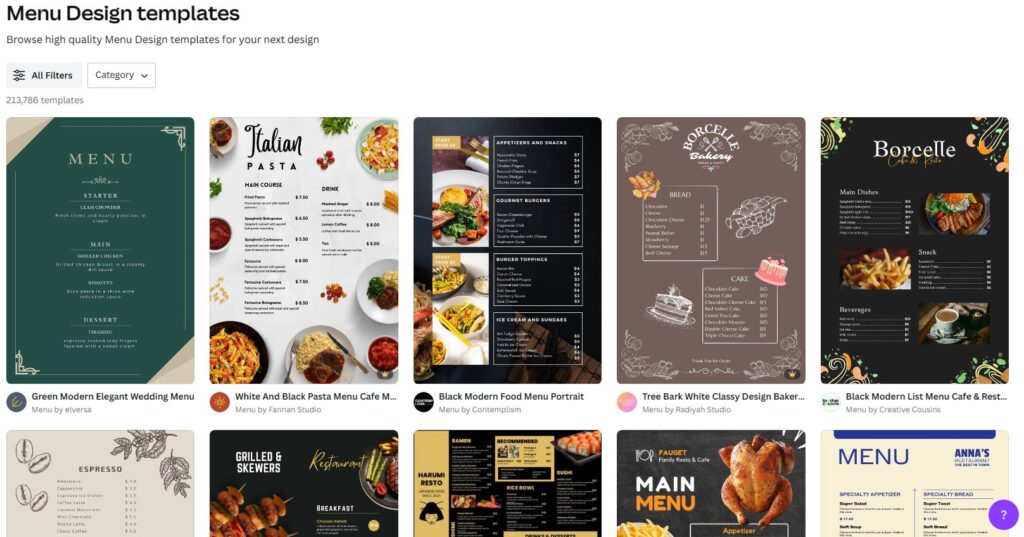
You can customize everything from the images to text and colors so that they match your brand identity. The easy-to-use interface will even allow you to easily adjust and rearrange each item so you can design according to your exact specifications and preferences.
If you want to explore other design tools, here’s a list of popular Canva alternatives.
8. Find the Right Type of Paper
When you’re happy with your menu design, we can get to printing. You’ll need to work with your local printer to understand the various types of paper and finishes available for menus. Some common examples include cardstock, matte, glossy, textured, laminated, etc.
You can even ask your printer for samples of these papers so you can see and feel the options firsthand. Ultimately, you’ll have to choose something that not only looks amazing but is also able to withstand the wear and tear of a restaurant environment.
9. Gather Feedback
Our work doesn’t end when the menu is finalized and in use. In fact, this is the stage where you need to be even more attentive to customer feedback and suggestions. You can ask them about their thoughts regarding the menu items, layout, or the overall experience.
This information can help us identify areas for improvement in your design. We can then make necessary adjustments to ensure that everything meets the needs and preferences of our customers.
Summing Up: How to Design a Menu
Designing a menu is an exciting process for any restaurant owner. It can also be a little tricky, but the steps we have discussed in this article will help you create something that truly reflects your vision. However, if you find yourself struggling with the design process, don’t hesitate to delegate this task to a professional.
We offer unlimited graphic design services that can help you design the perfect menu, along with other promotional materials such as social media graphics and ad graphics. We can even help you create a website for your business with a single subscription.
Just sign up now, and let’s bring your restaurant’s vision to life!

